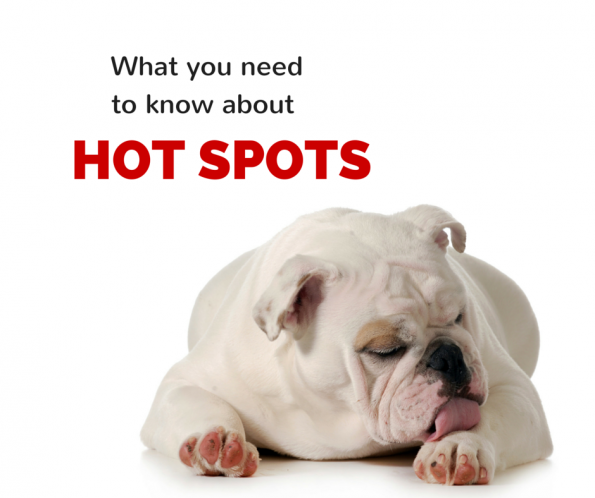In warm weather, one of the things veterinarians can count on is seeing more dogs with hot spots. These areas are weepy, wet, red and sometimes bloody when they are fresh, and dry and scabby when they are resolving. They can cover large areas of the dog’s skin, can appear as solitary lesions or in multiple locations, but are generally well defined. They are caused by over-zealous self-licking and chewing (the dog creates them) and they can arise quickly: 10 minutes of chewing can create a big one. The good news is that they almost always look worse than they are. The infection is usually superficial and often will resolve with topical treatment alone. The bad news is that about 30% of the pets presented for hot spots actually have some other kind of skin disease such as a deeper skin infection, bite wound or other trauma, or even immune-mediated ulceration. If you are not entirely sure about what a hot spot looks like, it is probably best to have your veterinarian look at it.
What Causes Hot Spots?
The dog causes the hot spot by self-chewing and licking. What causes the pet to self-chew and lick is another story. Most commonly your pet is reacting to an irritation to the skin such as a flea, mosquito or spider bite. It may have come in contact with an irritating substance, may have irritation from a grooming clipper, or it may have irritated skin from swimming in salt or dirty water. Anything that makes the dog itch will make the dog lick and chew, and if the licking and chewing is obsessive enough, a hot spot will soon follow.
First Aid
The basics of hot spot treatment are:
- Keep the dog from licking the area.
- Promote drying of the moist skin.
- Alleviate the itching that started the whole thing in the first place.
- Treat the secondary infection caused by the chewing
The best way to prevent your dog from licking the area is to either put a t-shirt on your dog that covers the affected area or an Elizabethan collar on our dog so it can not reach the area.
For smaller hot spots cleaning the area with an antiseptic soap and drying it well may be the only additional step you need to do.
If your dog is a frequent swimmer and is prone to hot spots, ensure you rinse your pet well with fresh water after swims and dry his coat off thoroughly afterwards. You may consider a trip to the groomer to clip his coat short during the summer to help facilitate rinsing and drying.
When to See the Veterinarian
Sometimes a hot spot is big and requires clipping the surrounding fur to dry it properly. Sometimes there are so many hot spots that topical treatment becomes impractical. A hot spot can be accompanied by a deeper skin infection elsewhere or an ear infection, either of which would require more extensive therapy. Treatment for a typical hot spot involves a topical antibacterial and anti-iinflammatory applied to the hot spot. More extensive treatments might include oral corticosteroids and/or oral antibiotics in addition to topical antiseptics and anti-inflammatories. You veterinarian will determine if that is needed.
Good flea control is important for any itchy pet and is the foundation of itch prevention. Always be sure you have flea control secured in the approach to any itchy pet.



